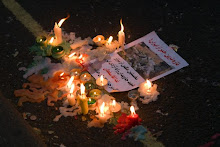Monday, 24 January 2011
Lamentations 2010 Rachel Kneebone at White Cube
Pictured above is an earlier work from an exhibition at The Barbican in 2010 - it gives a good idea of the way she works around the plinth.
Lamentations: Rachel Kneebone at White Cube
An exhibition of glistening white porcelain works, mounted on giant, monumental plinths, theatrically lit in a darkened room with painted black walls and called, ‘Lamentations,’ states unequivocally that you must take it seriously. You should approach with due solemnity and appropriate hush, and regard – probably for quite some time.
The title alone sounds literary. Add the theatrical staging and it suggests a Greek Tragedy. Actually being in the gallery, surrounded by the six Lamentations, felt more like being in a church awaiting Benediction or the Stations of the Cross, such was the depth of reverence in the atmosphere.
Even now, it is hard to say if these works lived up to their onerous atmospheric conditions. They are magnificently made and produced by an artist who knows her material intimately and who casts aside all anxieties about self-conscious knowingness and the need to make satirical references and, instead, takes the risks required to stride, apparently without fear, into an unlikely world of large-scale porcelain statuary.
I say ‘statuary’ because the six Lamentations seem to imitate statues. The porcelain in these works is playing the part of marble. They resemble the marble figures on graves and tombstones. They are each made up of a mass of writhing porcelain figures, doll-sized and mounted on porcelain plinths and glazed. Though the individual works are small, table-top sculptures, they read as large-scale because of the way they have been displayed. The porcelain pieces, including their plinths, are placed on another white plinth, which is itself placed on a black plinth, adding to the overall stagey effect. They imitate the tumbledown-ness of Victorian cemeteries. The porcelain plinths are cracking open and threatening to fall apart any minute. There’s a hint of eighteenth century gothic in the atmosphere.
‘As grave as the imagined as frivolous as the eternal,’ is the title of the first piece. It might be a pun, I assume it is, but the atmosphere was dictating due seriousness, so perhaps not. They all have long literary titles. A distorted figure with extended legs and weird oozing toes is draped over the knee of another distorted, faintly girlish figure. The pair is instantly reminiscent of Michelangelo’s Pieta and sits atop a wriggling mound of dismembered bodies and twisted, porcelain spaghetti-like strands. None of the figures have heads, or, if they have something in place of head, they have a vagina or a penis.
The plinths are an essential part of the narrative. Some are overtly tomb-like, cracking open and releasing the vile spirits, while others are barely discernible amidst the swathes, festoons and yet more ecstatic distorted figures. All the figures have either enlarged vaginas or vagina or penis heads. Some have small breasts with agonising torsos which resemble enlarged ribs or hands gripping and squeezing the body. There is an innocence in the girlish legs and arms, in the bottoms and feet and something tortuous in these finger-rib torsos.
Inevitably the vagina and penis heads are a reminder of the Chapman brothers’ rubbery confections and of the cartoon grotesques of Breughel. Kneebone’s references derive from three sources: ceramics, sculpture and painting. The Meissen shepherdesses are present, and the Sevres swathes and flowery festoons, as are the tortured souls of Italian Renaissance sculpture. What is interesting though is that she does not seem intimidated by any of them; there is no sense of genuflection. She certainly isn’t subverting them she seems to be saying, ‘yes, this looks like a Chapman figure and that looks like the foot of a Meissen shepherdess, the ankle of a Renaissance religious figure, the twirl of a Sevres swathe, but never mind all that, just follow these wounded souls into their torment or sorrow.’
I wasn’t entirely convinced but I’m still open to persuasion. I’d like to see them ‘out in the field,’ in a Renaissance or even Medieval church or ruined abbey. They don’t need those dutiful titles and I’m not sure they need all that theatre. They need to breathe air. For all the death and the sorrow and the lament, they are, very much about life. They teeter on the edge of ridiculous but that might be a strength. It’s just too easy to dismiss work like this, with the titles and the grandiose display, as absurd, pompous, overblown and, yes, ridiculous. The catalogue essays, though blisteringly professional and academically proper, don’t help. Partly because neither writer sounds entirely convinced either.
That said, David Elliott’s essay is very convincing in places. He discusses in particular Kneebone’s interest in realising female sexuality in art – wresting it from the persistent image of ‘lack’ and ‘absence.’ It is a detailed, involved, and sometimes passionate essay - so perhaps he is convinced – but here too, it is possible to over-write just as much as it is to over-display.
Kneebone is producing highly original, risky, substantial works. She uses porcelain in visceral, exciting and unorthodox way – mixing moments of studio pottery, (spaghetti strands and roses), moments of industrial production, (bottoms and feet), and moments of immensely Proper Sculpture. Putting aside the inflation and the derivation, they deserve and they reward serious contemplation.
Subscribe to:
Posts (Atom)












































